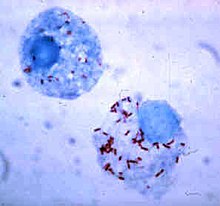This article needs additional citations for verification. (April 2011) |
| Rickettsiaceae | |
|---|---|

| |
| Rickettsia rickettsii (red dots) in the cell of a deer tick | |
| Scientific classification | |
| Domain: | Bacteria |
| Phylum: | Pseudomonadota |
| Class: | Alphaproteobacteria |
| Order: | Rickettsiales |
| Family: | Rickettsiaceae Pinkerton 1936 (Approved Lists 1980) |
| Tribes and genera | |
| |
The Rickettsiaceae are a family of bacteria. The genus Rickettsia is the most prominent genus within the family. The bacteria that eventually formed the mitochondrion (an organelle in eukaryotic cells) is believed to have originated from this family. Most human pathogens in this family are in genus Rickettsia. They spend part of their lifecycle in the bodies of arthropods such as ticks or lice, and are then transmitted to humans or other mammals by the bite of the arthropod. It contains Gram-negative bacteria, very sensitive to environmental exposure, thus is adapted to obligate intracellular infection. Rickettsia rickettsii is considered the prototypical infectious organism in the group.
- ^ a b Vannini C, Boscaro V, Ferrantini F, Benken KA, Mironov TI, Schweikert M, Görtz HD, Fokin SI, Sabaneyeva EV, Petroni G (2014). "Flagellar Movement in Two Bacteria of the Family Rickettsiaceae: A Re-Evaluation of Motility in an Evolutionary Perspective". PLOS ONE. 9 (2): e87718. Bibcode:2014PLoSO...987718V. doi:10.1371/journal.pone.0087718. PMC 3914857. PMID 24505307.